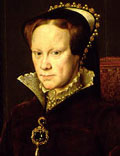 |
Mary Ib. 18 Feb 1516, Greenwich, near London |
| Title: | Dei Gracia Anglie, Francie et Hibernie Regina, Fidei Defensor, et in terra ecclesie Anglicane et Hibernice supremum caput (By the Grace of God, Queen of England, France, and Ireland, Defender of the Faith, and in the Earth Supreme Head of the Church of England and Ireland) [with changes to 25 Jul 1554] |
| Joint style: Philippus et Maria, Dei Gratia Rex et Regina Anglie, Francie, Neapolis, Ierusalem, et Hibernie; Fidei Defensores; Principes Hispanie et Sicilie; Archiduces Austrie; Duces Mediolani, Burgundie, et Brabancie; Comites Haspurgi, Flandrie, et Tirolis (Philip and Mary, by the grace of God King and Queen of England, France, Naples, Jerusalem, and Ireland; Defenders of the Faith; Princes of Spain and Sicily; Archdukes of Austria; Dukes of Milan, Burgundy, and Brabant; Counts of Hapsburg, Flanders, and Tyrol) [from 25 Jul 1554; further changes applied, see note] | |
| Term: | 19 Jul 1553 - 17 Nov 1558 |
| Chronology: | 19 Jul 1553, proclaimed queen in London [1] (entered London on 3 Aug 1553; regnal years counted from 6 Jul 1553) |
| 1 Oct 1553, crowned, Westminster Abbey | |
| 5 May 1554, assented to An Act, declaring the Regal Power of this Realm to be in the Queen's Highness, as fully and absolutely as ever it was in any of Her most Noble Progenitors, Kings of this Realm | |
| 25 Jul 1554, married Philip of Spain, Winchester | |
| 25 Jul 1554, royal titles publicly proclaimed at the wedding banquet, Winchester | |
| 16 Jan 1555, the title of Supreme Head of the Church of England and Ireland formally dropped by an act of Parliament | |
| 17 Nov 1558, died |
| Biography: | |
Mary was the daughter of Henry VIII and his first wife, Catherine of Aragon. When her father had planned to divorce Catherine in order to marry Anne Boleyn, Mary was sent to Ludlow Castle (1525), Wales, where she held her court. In 1534 the Act of Succession registered the invalidity of Henry's first marriage [2] and excluded Mary from the succession. After the birth of Edward on 12 Oct 1537 (later King Edward VI), Henry created his third Succession Act (1544), which included Mary and provided that she might occupy the throne if Edward died without issue. However, Edward VI, acting under the influence of his advisors, agreed to pass the throne to Lady Jane Grey, who was proclaimed (10 Jul 1553) queen upon his death. Considering herself the rightful heir, Mary refused to recognize the new queen and her claim was supported by the English nobility. The supporters of Jane Grey were forced to give up and Mary was proclaimed queen in London on 19 Jul 1553. She entered the capital on 3 Aug 1553. A fervent Catholic, Mary took course to restoration of Roman Catholicism and papal supremacy in England. She repealed all acts dealing with religious affairs passed in the reigns of Henry VIII and Edward VI. An insurrection provoked by the proposal of her marriage with Philip of Spain was immediately suppressed, and the marriage took place at Winchester on 25 Jul 1554. The first Parliament summoned after the marriage repealed the Act of Supremacy (1534), reinstated the heresy laws, and petitioned for reunion with Rome. As a result, around 300 Protestants were burnt in three years on charges of heresy earning Mary the epithet 'Bloody'. Although Philip was not created equal sovereign and was practically excluded from the actual government, Mary agreed to take part with Spain in the war with France (1557). In 1558 England lost Calais, the last remnant of the English conquests in France won during the Hundred Years' War. The disastrous war caused popular discontent, but Mary did not live to see its consequences. |
|
| | |
| [1] | Mary was proclaimed queen in Norfolk and Suffolk on 11 Jul 1553, Bury on 12 Jul 1553, Norwich on 13 Jul 1553; London on 19 Jul 1553 at Cheapside Cross and other accustomed places in the city. |
| [2] | The first public Act of the reign of Mary (1 Mary session 2 c.1) validated retroactively the marriage of Henry VIII and Catherine of Aragon, thus affirming Mary's legitimacy. |
| [3] | Handbook of British Chronology (1986) |
| [4] | "Mary Tudor: a life", by David Loades (Basil Blackwell, Cambridge, MA, 1989). |
| Image: portrait of Queen Mary I by Sir Anthony More (Antonio Moro), 1554. | |
